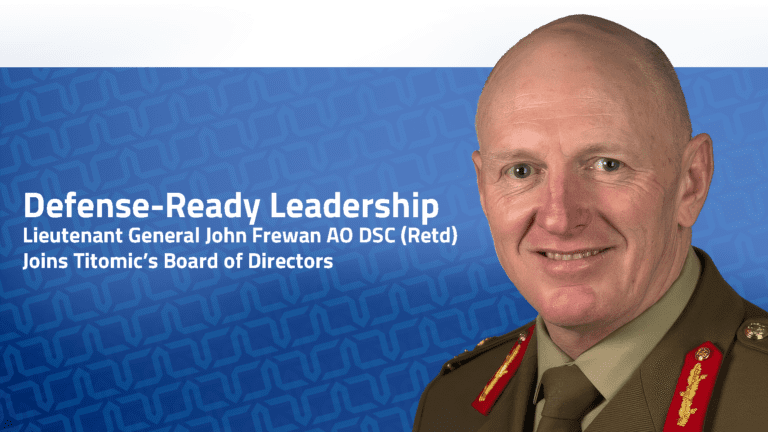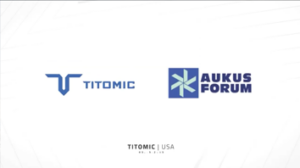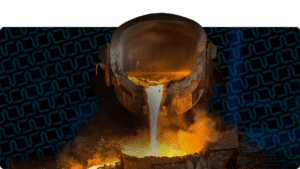Titomic Appoints Retired Lieutenant General John Frewen, AO, DSC as a Director

Huntsville, AL –Titomic Limited (ASX: TTT) (“Titomic” or the “Company”), a global leader in Titomic Kinetic Fusion™, a kinetic fusion cold spray additive manufacturing technology, announces the appointment of retired Lieutenant General John Frewen, AO, DSC as a Non-Executive Independent Director of the Company, with effect 1 July 2025. This appointment reflects Titomic’s deepening commitment to advancing sovereign industrial capabilities in Australia and globally. Lieutenant General Frewen is a recently retired senior officer in the Australian Defence Force with over 40 years’ proven leadership success including roles overseeing key defence, security and intelligence organisations; international military operations; and multi-agency government task forces. A third-generation army officer, he graduated from the Royal Military College, Duntroon, in 1986 and began his career as an Infantry Platoon Commander. General Frewen held numerous command positions, including leading the Second Battalion of the Royal Australian Regiment, the Army’s 1st Brigade in Darwin, and, in 2017, all Australian Forces in the Middle East. His operational service spanned multiple countries, including Rwanda, Solomon Islands, Afghanistan, and Iraq, where he demonstrated exceptional leadership in complex international environments. His expertise extends beyond traditional military roles. He served as Principal Deputy Director General of the Australian Signals Directorate and led the Department of Defence’s response to the COVID-19 pandemic. In 2021, he was appointed by the Prime Minister as Coordinator General of the National COVID-19 Vaccine Task Force, achieving one of the world’s highest vaccination rates. His final role in Defence was Chief of Joint Capabilities, overseeing the ADF Space and Cyber forces and Joint Logistics Command. During his tenure, all ADF space and cyber capabilities were consolidated for the first time, acknowledging the importance of these emergent warfighting domains. John is also an advisor to Gilmour Space, advisor to Salus Ventures, a Senior Fellow at Australian Strategic Policy Institute and a Patron of the ACT Veterans Rugby Union. Separately, Richard Willson has advised his intention to retire from the board with effect from July 1, 2025. Richard joined the board prior to the Company’s IPO in 2017. He has been a valuable member of the board, serving also as chair of the board’s Audit & Risk and Remuneration committees. The directors and officers of the Company thank Richard for his dedicated service over the past eight years.
“We are delighted to welcome John to Titomic. He is a truly exceptional leader with deep experience across defense and industry. Drawing on his vast experience, John will play an important role in bringing Titomic Kinetic Fusion™ value added capabilities to the Australian, U.S. and European manufacturing base helping defense and industry Build Smarter, Sustain Longer and Move Faster.
We are also very grateful to Richard Willson for his many years of board service.”Dag W.R. Stromme, Executive Chairman of the Board
“I am honored and excited to join Titomic’s board at this important moment in the Company’s history. With the recent establishment of global HQ and manufacturing facility in the U.S., ongoing European expansion, and firm commitment to Australia through its world class Melbourne facility, Titomic will be ideally positioned to deliver field-ready solutions that ensure mission readiness, extend asset life, and strengthen the Australian, the U.S. and their allies’ industrial base with next-generation manufacturing capability.”
Lieutenant General Frewen, Independent Non-Executive Director
This Board appointment reinforces Titomic’s position as a leader in advanced manufacturing as well as coating and repair technologies, furthering its commitment to providing timely and innovative solutions to defense and aerospace customers worldwide.
This announcement has been authorized for release by the Board of Titomic Limited.
END
Frequently asked questions
TKF costs significantly less than traditional manufacturing methods for the following reasons:
- It doesn’t need large-scale tooling (such as vacuum moulds) to produce parts. A simpler setup means reduced costs.
- It turns metal powder to part in just hours, by depositing the powder at supersonic speed to rapidly build up parts layer by layer – so there’s no need for casting or forging. Plus, the part you need is the part you make, saving time and materials.
- It keeps material costs down. For example, when we manufactured a 1.2m titanium ring, the ‘as built’ weight was 60kg while the final part weighed 56kg – representing a ‘buy to fly’ ratio of 1.08 with material costs of only A$3,000.
Our compact cold spray systems cost considerably less than traditional repair and resurfacing methods for the following reasons:
- You can resurface and refurbish parts in just minutes.
- Materials often cost less than $300.
- You no longer need to outsource repairs. For example, a shower floor manufacturer quoted $40,000 to ship a damaged resin transfer moulding tool overseas spent just $3,000 repairing it with Titomic’s D523 system – as well as saving months of downtime.
We’ve achieved typical density rates of 90-95% and over 99% when enhanced by post-processing.
If needed, it’s also possible to create less dense, more porous coatings for grip, abrasion, chemical processing and more through process optimisation, powder manipulation, and post-processing parameters.
Generally, you can achieve mechanical properties similar to casting and forging. While some parts may need to be processed with a heat treatment to make them more ductile, we can tailor process variables to meet your specific needs – a clear advantage compared to other methods.
It depends on what parts you need, as well as the mechanical properties the application requires. However, generally parts created with TKF will need some post-processing heat treatment.
Cold spray doesn’t require heat to melt the materials being sprayed. This is different to traditional metal spraying methods like welding or thermal spraying, which use heat to melt the material before it’s applied to a surface.
Instead, a high-pressure gas is used to accelerate tiny metal particles (which are usually less than 50 micrometres in size) to supersonic speeds. This creates heat through kinetic energy, when the particles collide with the surface of the object being sprayed.
Cold spray works by exploiting the kinetic energy of tiny metal particles. Low-to-high pressure gas is used to accelerate the particles (which are usually less than 50 micrometres in size) to supersonic speeds. These are then sprayed onto a surface where they compress and deform to create a cohesive bond.
This results in a strong, dense coating that can be used for a variety of applications – such as repairing damaged parts, improving the surface properties of a material, or creating new, complex shapes.
There are many metals that can be used in our cold spray systems. This includes aluminium, copper, nickel, titanium, stainless steel, Inconel, and more.
Since these all have different characteristics – such as strength, ductility, and resistance to corrosion – the chosen metals will depend on the application, as well as the properties needed for the final product.
Some metals may also be easier or more difficult to cold spray, depending on their melting point, ductility, and other factors.
What makes TKF so beneficial is that it can fuse dissimilar metals together. This means you can leverage the strengths of multiple metals in a single, monocoque part. For instance, you can fuse copper to titanium, nickel to cast iron, and much more.
Cold spray can be used on a variety of surfaces. This includes metals, ceramics, plastics, and composites.
The process is particularly useful for repairing worn or damaged metal parts, as it can restore the surface to its original shape and properties without causing distortion or weakening the material.
Our cold spray systems can also be used to add new features or properties to a surface, such as improved wear resistance, corrosion resistance, or thermal properties.
You can even use it to create new shapes or structures that would be difficult or impossible to achieve with traditional manufacturing methods.
- Aerospace: Repair and restore worn or damaged aircraft parts (such as engine blades, landing gear, and wing components), or add corrosion-resistant coatings to aircraft surfaces.
- Automotive: Repair and restore worn or damaged engine components (such as pistons, cylinder heads, and crankshafts), or add wear-resistant coatings to automotive parts.
- Marine: Repair and restore worn or damaged marine components (such as propellers, shafts, and rudders) or add corrosion-resistant coatings to marine structures.
- Oil & gas: Repair and restore corrosion and wear (such as shafts, bearings, piping, and valves).
- Electronics: Add conductive coatings to electronic components (such as circuit boards and antennas), as well as repair and restore electronic devices.
- Manufacturing: Create new shapes or features on metal parts (such as textured surfaces or complex geometries), or add wear-resistant coatings to industrial components (such as machine tools and moulds).



